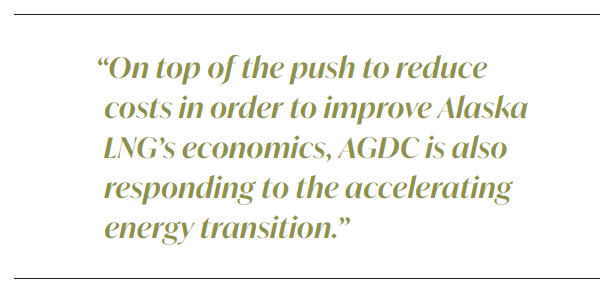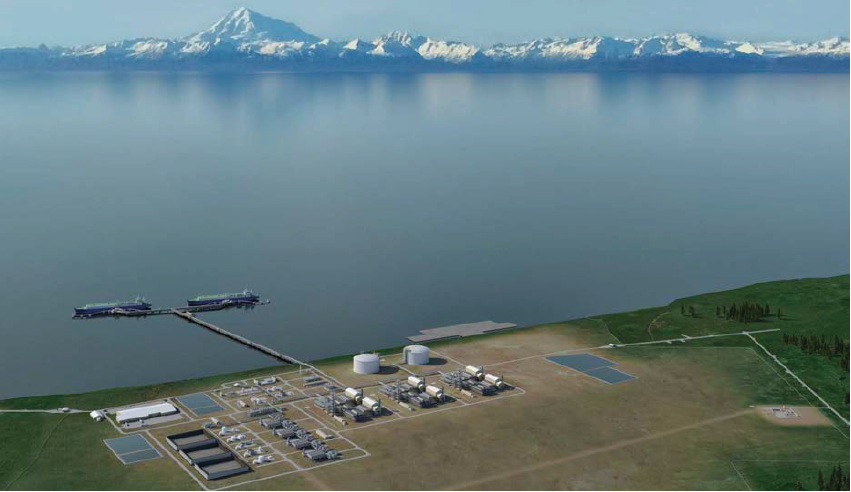AGDC hopes to add value to Alaska LNG with hydrogen hub proposal [Gas in Transition]
The Alaska Gasline Development Corp (AGDC) continues its efforts to boost the value of its proposed Alaska LNG export project in a bid to ensure it is ultimately built. On November 7, the company announced that it had submitted a concept paper to the US Department of Energy (DoE), outlining a proposal for a blue hydrogen production hub in Alaska.
Under the plan, hydrogen would be produced using feedstock gas from Alaska LNG, while the associated CO2 emissions would be sequestered. AGDC hopes to obtain federal funding under the 2021 Bipartisan Infrastructure Law, with the DoE set to select 6-10 hydrogen hub proposals that will be awarded up to $7bn in funding on a combined basis. AGDC’s proposal anticipates requiring $850mn in DoE funding, alongside $3.75bn worth of private sector funding.
The company envisions the hydrogen hub initially producing more than 600 metric tons/day of hydrogen, well above the DoE’s minimum requirement of 50 mt/d for the projects it will select. Eventually, AGDC expects that the hub’s capacity will grow to 1,600 mt/d.
The proposal is also supported by Agrium US, the Salamatof Native Association, the Alaska CCUS Consortium – including ASRC Energy Services, Santos and Storegga – and the University of Alaska Fairbanks' Alaska Center for Energy and Power (ACEP).
Evolving plan
The proposal represents the latest change to the broader plan for Alaska LNG, which was taken over by state-owned AGDC in 2017 after BP, ConocoPhillips and ExxonMobil dropped out. Since then, the company has worked to bring down the costs of the project, which were considered prohibitively high at an estimate of $44.2bn in 2015.
In 2020, AGDC released an updated cost estimate for the project, now putting it at $38.7bn, down 12.4% on the previous projection. And in early 2022, consultancy Wood Mackenzie produced a report for AGDC which found that project improvements had enabled Alaska LNG to reduce its cost of supply by 43%, from $11.7/mn Btu to $6.7/mn Btu. The consultancy’s analysis identified further cost reduction opportunities for the project and estimated Japanese spot LNG prices at $8/mn Btu – above Alaska LNG’s cost of supply.
Transition drivers
On top of the push to reduce costs in order to improve Alaska LNG’s economics, AGDC is also responding to the accelerating energy transition. Against the backdrop of a decarbonising world, developers anticipate that clean energy credentials will make it easier to advance major projects over the longer term.
LNG producers are already talking up their projects as having the potential to help consumers – especially in Asia – move away from more polluting coal. In addition to this, AGDC has increasingly been looking at emerging forms of cleaner energy. In October, the company said it was partnering with Mitsubishi, TOYO Engineering and Hilcorp Alaska to evaluate the commercial feasibility of using North Slope gas delivered to Southcentral Alaska via the Alaska LNG project to produce carbon-free ammonia. Ammonia is a hydrogen carrier, and the new hydrogen hub proposal represents another push into exploring the potential to develop these cleaner energies.
The LNG project aims to monetise stranded gas resources on Alaska’s North Slope, targeting buyers in Asia. Using some of that gas to produce hydrogen represents one more option for AGDC that may find favour in a decarbonising world. Alaskan hydrogen production was also under discussion with Japanese energy leaders during the Alaska LNG Summit, held in Tokyo in October.
Advantages
Despite the cost reductions that AGDC has made, Alaska LNG remains expensive, while clean hydrogen development is still a nascent industry, complicating the path forward for any major new hydrogen projects. However, supporters of the LNG project and hydrogen hub have highlighted a variety of factors they hope will play to the projects’ advantage.
“Alaska is uniquely positioned in Pacific energy markets because it has the only known geologic carbon storage potential at tidewater on the West Coast of North America,” ACEP’s associate vice chancellor of research for innovation and industry partnerships, Gwen Holdmann, tells NGW. “Carbon storage is important because it allows for the long-term geologic storage of greenhouse gases associated with production of hydrogen from natural gas reserves, thereby minimising overall emissions that contribute to global warming.”
Holdmann notes that the now mothballed Kenai LNG project involved shipping the super-chilled fuel from Alaska to Japan, paving the way for other projects to use the same route.
 “There is strong interest on both sides in exploring new strategic partnership opportunities, especially around low-carbon fuels,” she says. Indeed, Holdmann also views the Alaska hydrogen hub as being unique for its “potential for drawing strong international interest and investment from Asian neighbours such as Japan”. And AGDC will be counting on attracting such interest, given that its proposal anticipates $3.75bn in private sector funding requirements. Indeed, the company noted in its announcement that the private sector funding would be backed by offtake agreements with hydrogen customers in both the US and Asia.
“There is strong interest on both sides in exploring new strategic partnership opportunities, especially around low-carbon fuels,” she says. Indeed, Holdmann also views the Alaska hydrogen hub as being unique for its “potential for drawing strong international interest and investment from Asian neighbours such as Japan”. And AGDC will be counting on attracting such interest, given that its proposal anticipates $3.75bn in private sector funding requirements. Indeed, the company noted in its announcement that the private sector funding would be backed by offtake agreements with hydrogen customers in both the US and Asia.
“Coupled with its proximity to Asian markets that are interested in meeting domestic goals for decarbonising their energy supply, Alaska could become a key global player in the production and export of low-carbon fuels,” says Holdmann. “Alaska is very interested in marketing its extensive natural gas resources and offering lower-carbon products in addition to LNG could make Alaska gas more competitive.”
Obtaining federal funding is seen as equally important – at least initially – even though this portion represents a smaller amount of the overall funding requirements for the hydrogen hub proposal.
“Federal funding for initiatives such as the Alaska hydrogen hub can be critically important for reducing risk and jump-starting what is really a whole new industry,” says Holdmann. “Alaska has a lot of the parts and pieces and certainly the resources needed to move an initiative like this forward, but we need a catalyst to make this leap. It’s well understood here that, ultimately, a programme like this cannot rely solely on government funding, and the expectation is that the project can and will be financially and economically self-sufficient in the long-term.”
Next steps
The Alaska LNG proposal has been slow-moving, and getting the hydrogen hub off the ground, if it proceeds, would also take time. The DoE is expected to decide which hydrogen hub proposals will receive federal funding in late 2023 or early 2024.
Efforts are further complicated by the fact that AGDC is working to hand over Alaska LNG to a private operator. If it succeeds, a final investment decision (FID) on the LNG project could come around 2024, with the facility then entering service sometime around 2030. However, it is currently unknown what impact a handover of ownership would have on the hydrogen hub proposal, which remains at an early stage.
Supporters of the broader Alaska LNG project hope that the war in Ukraine and the resulting upheaval in global energy flows will help the project’s prospects of being built. However, others remain sceptical over its future, given its high costs and ambitious scope. But while adding a blue hydrogen component represents a new challenge, it could work in the project’s favour as the trade in cleaner fuels takes off.
And if the DoE selects the hub to receive federal funding, that would likely provide a significant boost in momentum for the broader Alaska LNG plan, as well as the hub itself.



